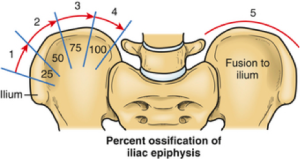Last Updated on October 28, 2023
The Risser sign, also called Risser index or Risser classification is a system used to assess and grade skeletal maturity based on the level of ossification and fusion of the iliac crest apophyses.
The apophyses (singular: apophysis) are the normal bony outgrowths which have separate ossification centers and eventually fuse with the bone in time. Iliac crest and greater trochanter are examples of apophyses.
Risser sign is used in scoliosis when corrective surgery is planned.
Scoliotic curves progress with the growth of the skeleton and Risser sign helps to gauge the likelihood of progression of the curve by assessing the growth potential that is present.
As noted previously it is a radiographic evaluation and x-rays are required for evaluating this sign.

Image Credit: vsrc.com.au
Risser Sign Grading
The sign is gauged on anteroposterior view x-ray of the pelvis.
On x-ray, the amount of ossification of iliac apophysis and is graded from 0 – 5. The process of ossification begins anteriorly and moves to posterior on the apophysis.
The grading is as follows
- Grade I – Ossification of the lateral 25% of the iliac apophysis
- Grade II – Ossification of the lateral 50%
- Grade III- Ossification of the lateral 75% of the apophysis
- Grade IV – Ossification of the entire [100%] apophysis
- Grade V – Fusion of ossified epiphysis to the iliac wing
Significance of Risser Sign
As noted before the curves of scoliosis progress during periods of rapid growth.
Thus the progression is more in infancy and adolescence, and they stop growing after spinal maturation is complete.
Males and females stop growing at different ages.
Growth of the spine is completed at approximately 15 years 3 months of age in female adolescents. In male adolescents, the age of this completion is 15 years and 10 months.
This completion or maturation of spinal growth coincides with the completion of ossification in the iliac apophysis.
The ossification of iliac apophysis begins around 15 years in male adolescents and around 14 years in females.
Thus the whole process of ossification from stage I to stage IV takes around 12-18 months.
After the ossification, the apophysis fuses with iliac crests. The fusion takes around two years in girls and slightly lesser time in boys.
But the progression does not occur after Risser sign grade IV has been achieved.
Some other factors are also responsible for the progression of the curve in addition to skeletal growth. But then also the progression is not as fast as when the skeleton is growing.
For example, if the curve is severe say 50-80° at the time of maturity, it may progress even after the apophysis has fused. This is especially true for the lumbar and thoracic regions.
But the progression occurs far slower than that occurs when growth is pending.
Drawbacks of Risser Sign
Objections have been recently raised to Risser index.
Risser index may not be that reliable. The studies have suggested that ossification starts earlier what we thought previously. Therefore, the predictability and hence reliability is doubtful.
The accuracy of the index is also questioned as the recent data has indicated that this index is not an accurate measure of completed maturity, spinal growth, or progression of the deformity.
In view of these observations, alternate methods of ascertaining the maturity have been suggested.
One such method is ossification of the vertebral ring apophysis.
Before skeletal maturity is attained, the vertebral ring apophysis is absent, or it is incompletely formed.
In some cases, it could be completely formed without fusing to the body.
The vertebral ring apophysis fuses to the body of the vertebra after skeletal maturity.
This fusion occurs by the age of 16 years in female adolescents.
In male adolescents, the age of this fusion is 19 years.